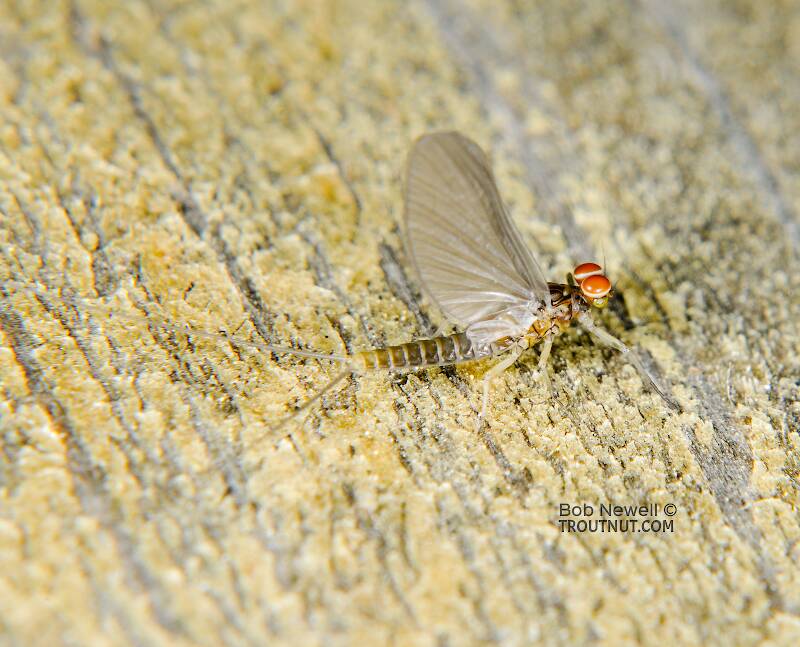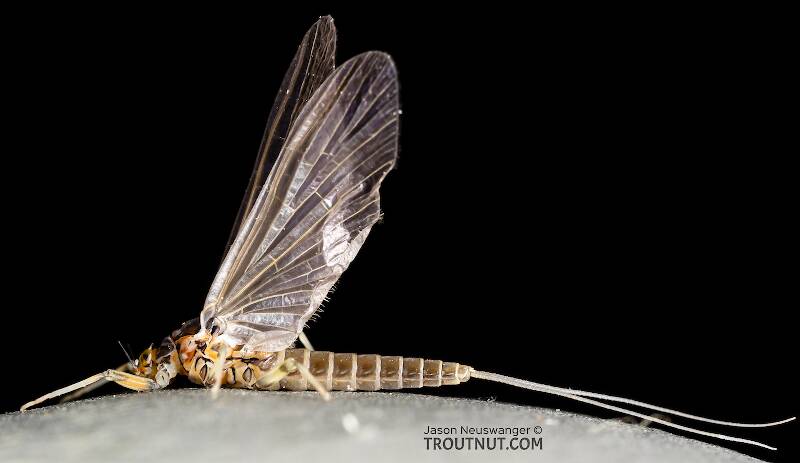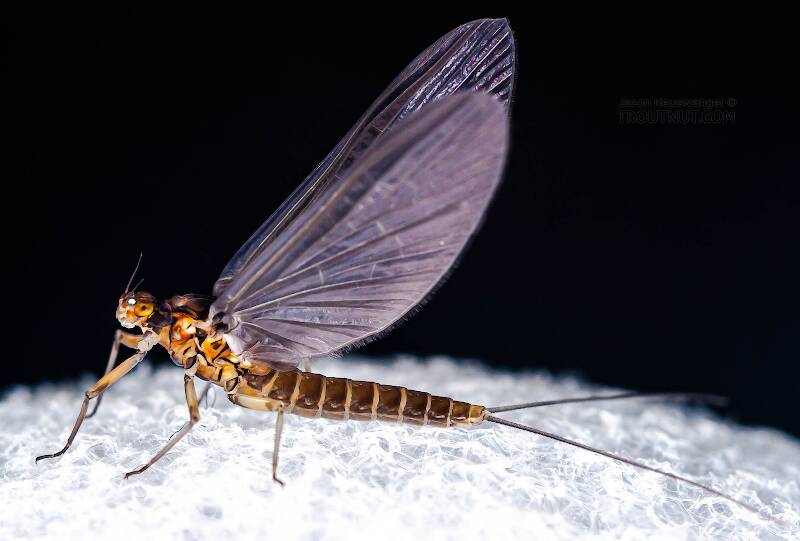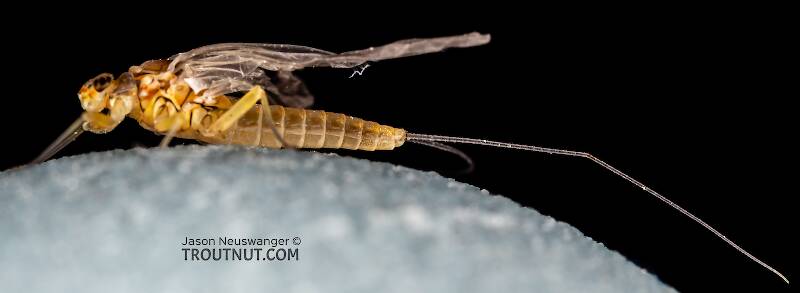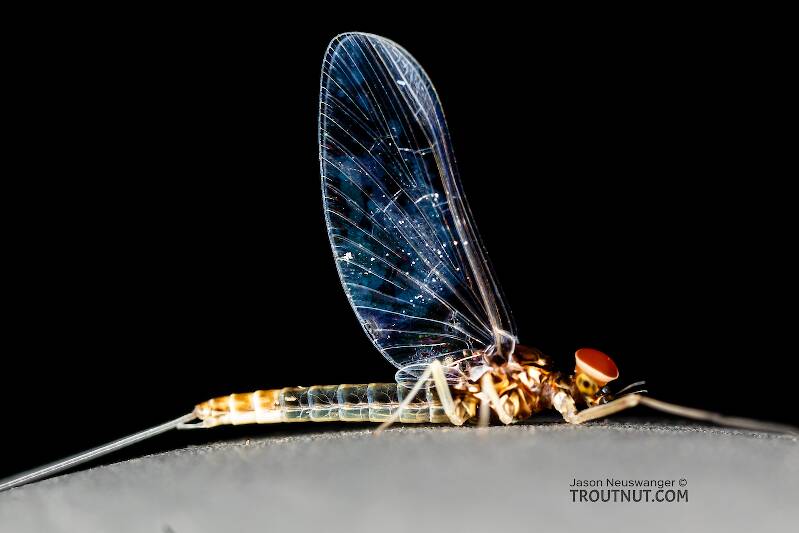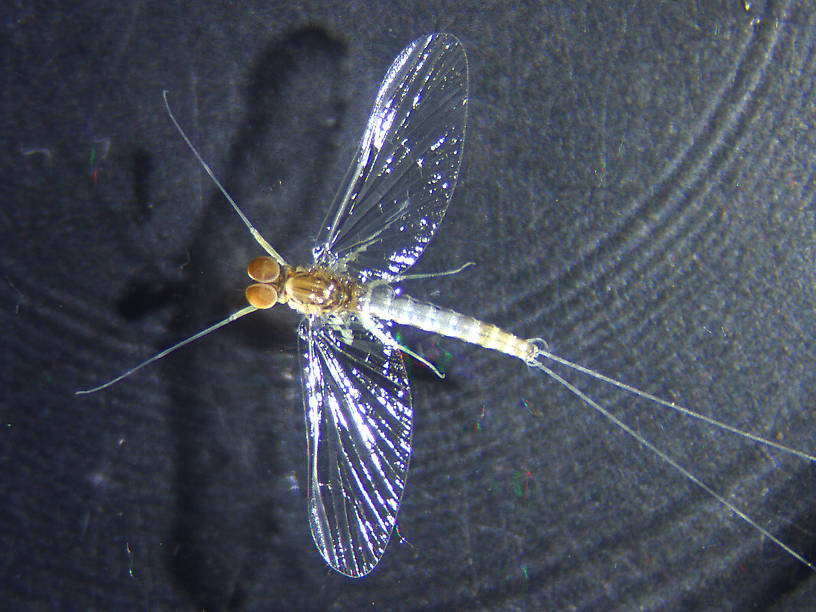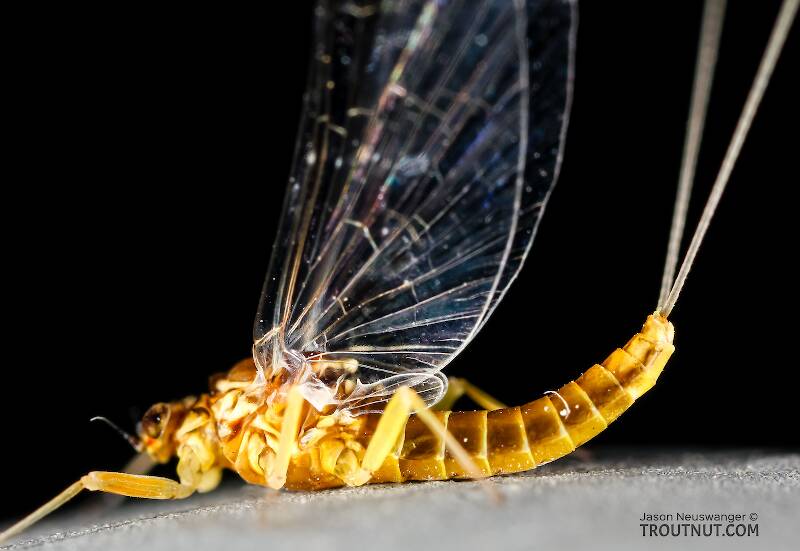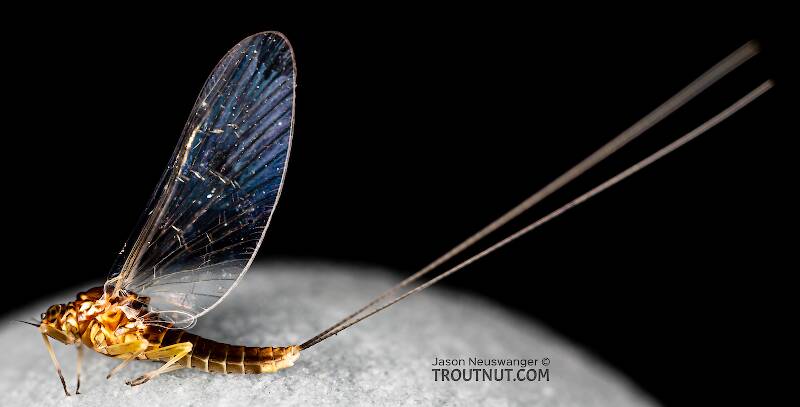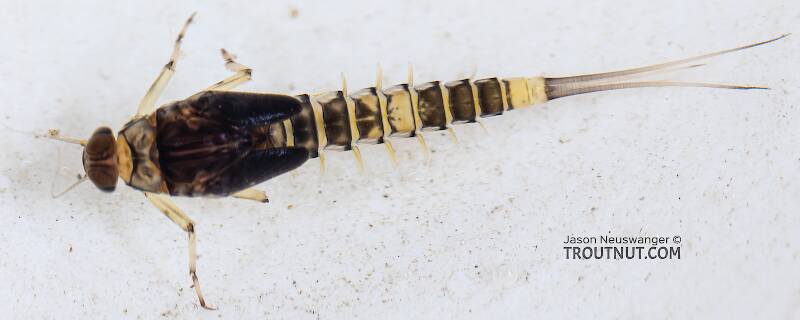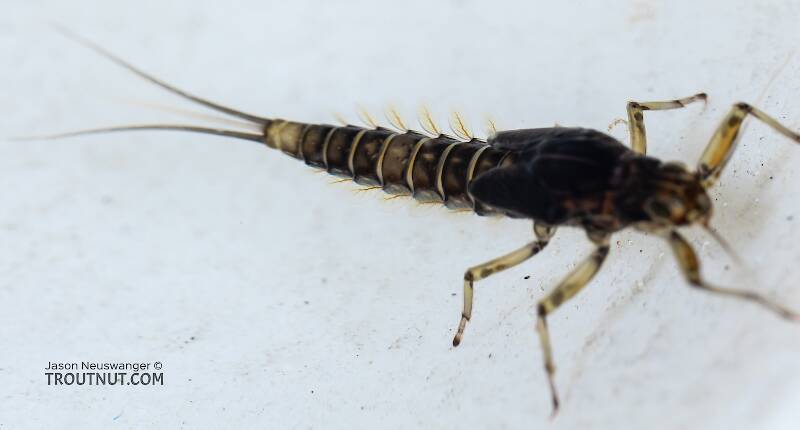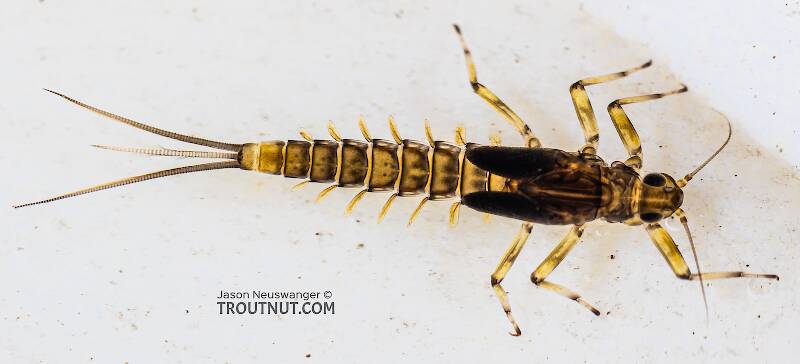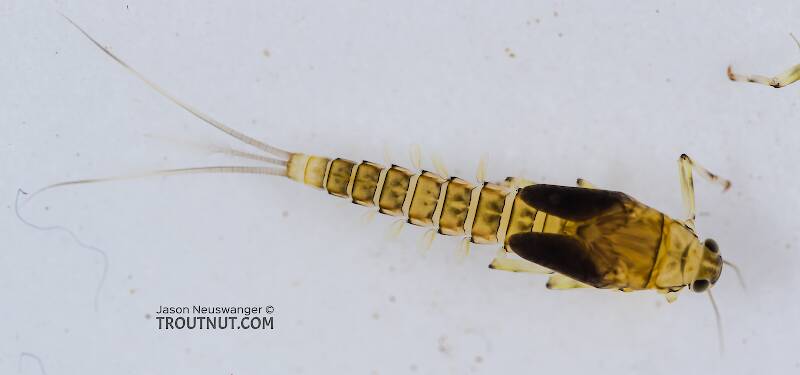
Salmonflies
Pteronarcys californica
The giant Salmonflies of the Western mountains are legendary for their proclivity to elicit consistent dry-fly action and ferocious strikes.

Mayfly Species Baetis tricaudatus (Blue-Winged Olives)
Where & when
In 58 records from GBIF, adults of this species have mostly been collected during June (28%), April (24%), May (12%), August (10%), July (10%), September (5%), and March (5%).
In 143 records from GBIF, this species has been collected at elevations ranging from 49 to 10522 ft, with an average (median) of 5118 ft.
Species Range
Hatching behavior
Spinner behavior
Time of day: Variable
Habitat: Same habitat as the emergence
Nymph biology
Current speed: Any
Substrate: Gravel, vegetation
Physical description
Most physical descriptions on Troutnut are direct or slightly edited quotes from the original scientific sources describing or updating the species, although there may be errors in copying them to this website. Such descriptions aren't always definitive, because species often turn out to be more variable than the original describers observed. In some cases, only a single specimen was described! However, they are useful starting points.
Male Spinner
Wing length: 5-8 mm
No color characters given. Genitalia of the moffati type (now a synonym of Baetis tricaudatus). Hind wing with three veins, the third running close to the hind margin to beyond the middle. Veins 1 and 2 converge distinctly toward the tip. Upper margin of hind wing almost straight, beyond the costal projection, which is quite well developed. Between veins 2 and 3 are two intercalaries, the second of which extends up from the hind margin toward the 2nd vein. The inner margin of the second (cylindrical) joint distinctly irregular and of a wrinkled appearance.
Described as B. incertans
Body length 4.5 mm, wing length 5 mm
Abdominal tergites 2-6 of male imago olive brown, the posterior margins deeper ruddy brown; genitalia of the moffati type (now a synonym of Baetis tricaudatus).
Turbinate eyes moderate in size; red-brown. Head and thorax deep olive brown. Scutellum and posterior margins of the mesonotum only slightly paler; anterior projection of the metanotum whitish; pleura with ruddy brown tinges. Femora pale yellowish; tibiae and tarsi dirty whitish, a smoky apical spot on the fore tibia. Wings hyaline, venation pale. About 6 cross veins in the stigmatic area of the fore wing, with only slight granulations between them; veins not anastomosed. First pair of intercalaries obsolescent, second and third pairs rather short, subequal. Hind wing broad, more than twice as long as its width; third vein rather weak, running close to the hind margin. Between the 2nd and 3rd vein are two strong intercalaries.
Abdominal tergites olive brown; 2-6 semi-translucent and narrowly deeper ruddy brown on the posterior margins; 7-10 opaque. Sternites pale yellowish white, the apical ones opaque. Tails and forceps white. The smaller size, smaller turbinate eyes, and abdomen more evenly brown in color, separate this species from vagans (now a synonym of Baetis tricaudatus).
Described as B. moffati
Body length 7 mm, wing length 7.5 mm
Abdominal tergites 2-6 of male imago brownish; genitalia of the moffati type (now a synonym of Baetis tricaudatus), see fig. 164, (second forceps joint cylindrical, no tubercle on the inner apical margin of the first joint).
Turbinate eyes somewhat shriveled, but appear to be of moderate size; reddish orange in color. Antennae pale reddish. Head and thorax deep red-brown, the mesonota and metanota much darker red-brown, almost blackish on the margins of the mesonotal scutellum. Postero-lateral and lateral margins of the pronotum darker than central area. Antero-lateral margin of mesonotum, and several sutures of pleura and sternum, blackish. Fore leg reddish brown, tip of tarsus rather paler. Apical margins of coxa, trochanter and femur, and base of tibia, deep reddish black. Only stubs of middle and hind legs remain; these are paler reddish brown. Wings hyaline, venation pale yellowish brown in costal half of fore wing, elsewhere pale. Hind wing rather large; three veins, the third rather faint and running close to the hind margin to a little beyond the middle. Costal projection well developed. No intercalaries (see fig. 163).
Abdominal segments 2-6 light reddish brown, in part semi-translucent; tergites only slightly darker than sternites; intersegmental areas pale hyaline, giving the abdomen an annulate appearance. Segments 7-10 opaque, darker reddish brown, especially on the dorsum. Genitalia of the moffati type; basal joint of forceps large, with no tubercle on the inner apical margin; second joint swollen and cylindrical in shape, usually considerably shorter than the third more slender joint; fourth joint much shorter than the third, about as long as the second.
Described as B. parallelus
Body length ? mm, wing length 8 mm
Head and thorax pale brown; margin of mesonotum hardly more yellow; remainder of mesonotum dark shining brown, sternum partly brown. Fore legs pale brownish, middle and hind legs pale. Wings hyaline, venation pale. Intercalaries of the fore wing moderately long. Hind wing elongate, the sides nearly parallel. Third vein quite well developed. One rather long intercalary between the 2nd and 3rd veins. Costal projection sharp.
Abdominal tergites 2-6 brownish; 7-10 darker brown. Sternites pale. Tails pale, darker at the joinings.
Described as B. vagans
Body length 6 mm, wing length 6 mm
Abdominal tergites 2-6 of male imago dull olive brown; genitalia of the moffati type (now a synonym of Baetis tricaudata).
Turbinate eyes very large, deep red-brown. Head and thorax deep pitch brown; a pale yellowish spot is usually present on each side of the anterior tubercle of the mesonotum; scutellum pale brown; anterior to the scutellum, and on the postero-lateral margins, are light ruddy brown shadings. Paler brown shading on the pleural sutures.
Anterior margin of metanotum, and its anterior projection, distinctly whitish. Legs dull yellowish white; fore femur distinctly tinged with brown, and a small dark patch near the apex of the fore tibia. Wings hyaline, venation pale. Cross veins in the stigmatic area of the fore wing strongly anastomosed, forming an irregular network. First pair of intercalaries usually not well developed, may be broken; second and third pairs moderately long, subequal. Hind wing twice as long as its width. Third vein well developed, running to the middle of the hind margin. One or two intercalaries between veins 2 and 3, and traces of one or two intercalaries between veins 1 and 2 (see fig. 163).
Abdominal tergites 2-6 dull olive brown, paler on the anterior margins, semi-hyaline; a dark ruddy brown line marks the posterior margin, but does not extend along the lateral area. Tergites 7-10 opaque, ruddy or chocolate brown. Sternites 2-8 pale smoky semi-translucent; 7-10 pale whitish brown. Tails white. Tracheae in the spiracular area more or less marked with black. It is larger than the related species B. incertans (now a synonym of B. tricaudata), and with larger turbinate eyes.
Specimens of the Mayfly Species Baetis tricaudatus
2 Male Duns
3 Female Duns
2 Male Spinners
2 Female Spinners
4 Nymphs
Start a Discussion of Baetis tricaudatus
References
- Arbona, Fred Jr. 1989. Mayflies, the Angler, and the Trout. Nick Lyons Books.
- Caucci, Al and Nastasi, Bob. 2004. Hatches II. The Lyons Press.
- Knopp, Malcolm and Robert Cormier. 1997. Mayflies: An Angler's Study of Trout Water Ephemeroptera . The Lyons Press.
- Leonard, Justin W. and Fannie A. Leonard. 1962. Mayflies of Michigan Trout Streams. Cranbrook Institute of Science.
- Needham, James G., Jay R. Traver, and Yin-Chi Hsu. 1935. The Biology of Mayflies. Comstock Publishing Company, Inc.
- Swisher, Doug and Carl Richards. 2000. Selective Trout. The Lyons Press.
Mayfly Species Baetis tricaudatus (Blue-Winged Olives)
Species Range
Common Names
Resources
- NatureServe
- Integrated Taxonomic Information System
- Global Biodiversity Information Facility
- Described by Dodds (1923)




